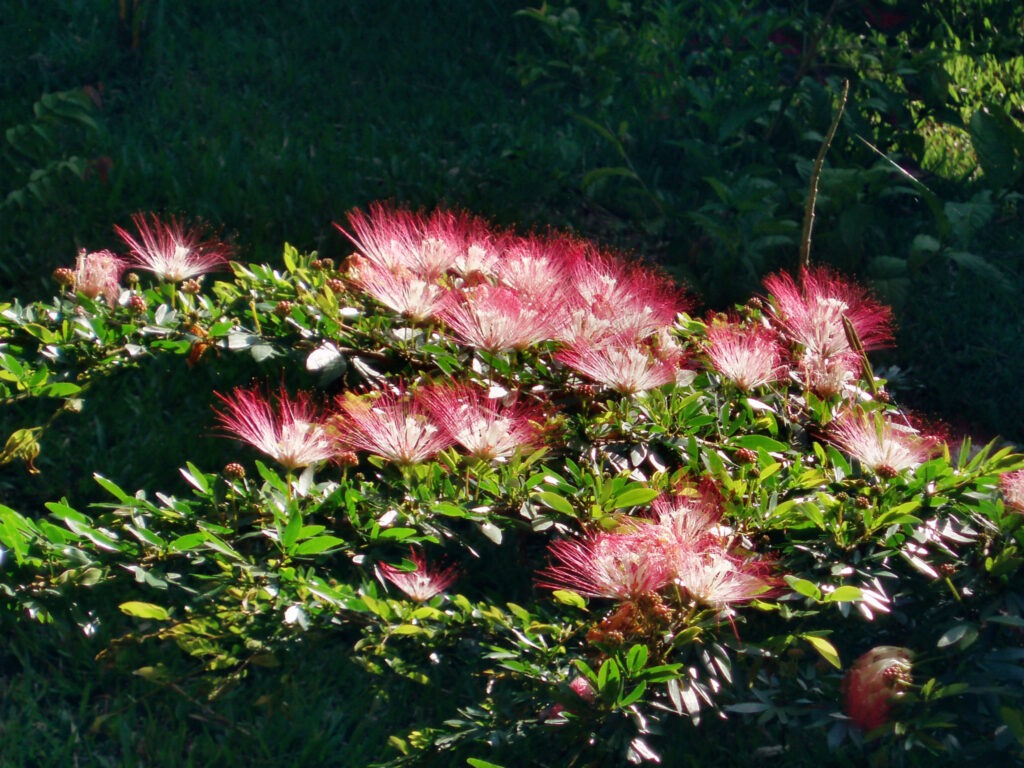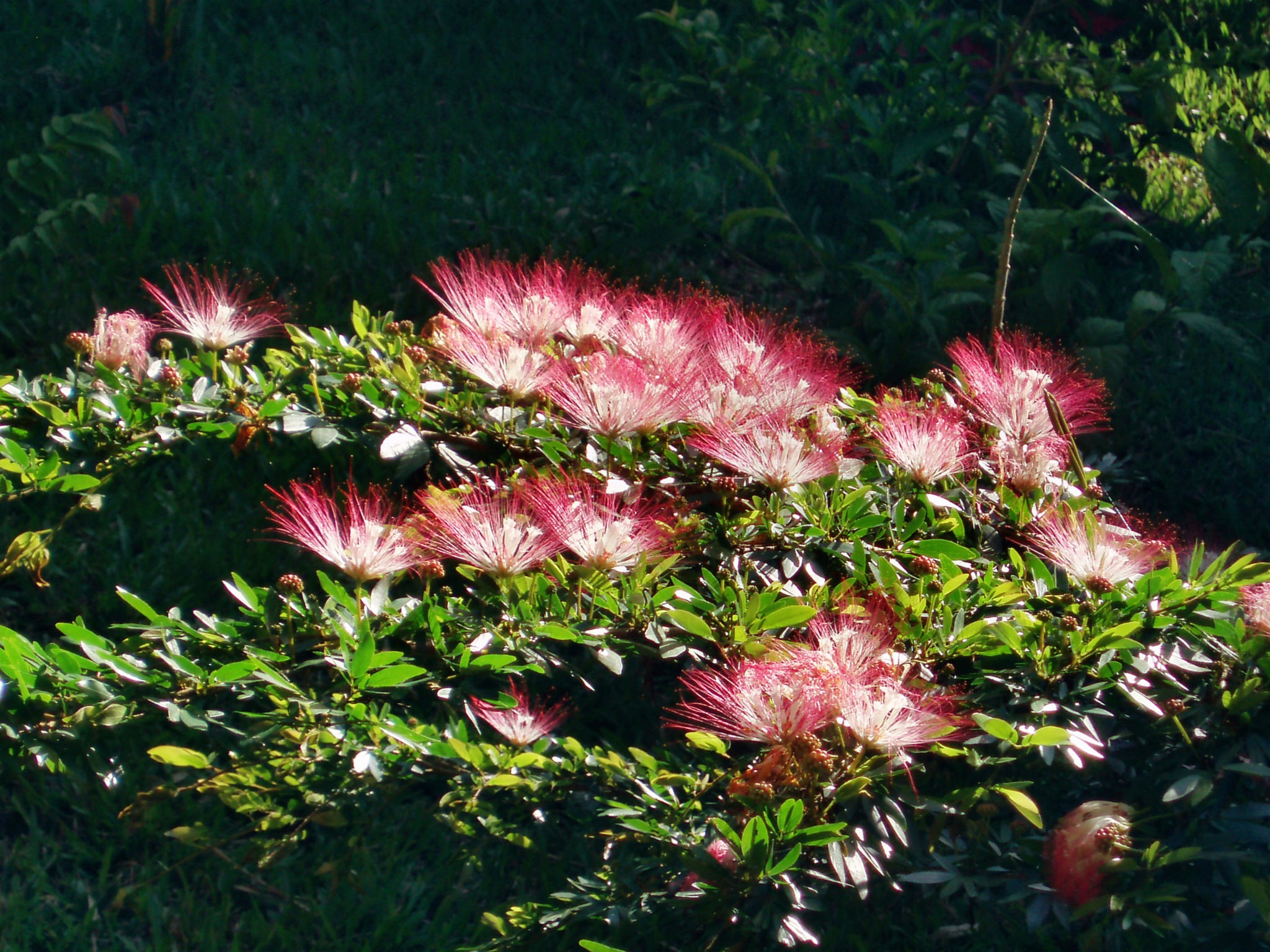Bobinsia

Servings
4
Ready In:
2hrs 45min
Calories:
610
Good For:
Lunch
Bobinsia
A wonderful Amazonian medicinal, healing and master teacher plant

Local name(s):
Bobinsana
Origin of the local name (s): It appears that bobinsana might be a name that has been given to the plant by those outside of the indigenous communities, and its exact origin may not be directly tied to a specific indigenous language or culture. English name(s): powder-puff/ powder puff plant, fairy duster and narrow-leaved calliandra.
Other names:
quinilla blanca, chipero, balata, bushiglla, capabo, cigana South Amerindian
Indigenous names: o Amahuaca or Amhuaca: Newei o Ece’je or Ese eja: Sháwi o Wachipaeri, or Huachipaeri, and Huachipaire: Yopoyo o Matsigenka, Matsigenga or Machiguenga: Kuanti o Mashco-Piro, Mascho Piro, also known as the Cujareño people and Nomole; Yine: Kopnipi o Shipibo-Conibo: Semein o Quechua: Kori sacha o Ecuador: yacu yutzu Scientific name(s): Calliandra angustifolia Spruce ex Benth. Calliandra pentandra (?)
Origin of the scientific name: The genus name “Calliandra” comes from Greek words ‘kalli-‘ meaning “beautiful” and ‘andros’ meaning “male, warrior”, a reference to beauty of its stamens, the masculine part of the flower, which has the shape of the small colour duster. The species name “angustifolia” is derived from Latin, meaning “narrow-leaved.” Family Fabaceae ( legume, pea, or bean family).
it can form symbiotic relationships with soil bacteria to fix nitrogen, which helps enrich the soil, thus this family includes many economically important plants.
Introduction
Genus of pinnate-leaved shrubs and small trees of tropical and subtropical North and South America, Bharata aka India and West Africa, valued for their fine foliage and attractive spreading habit and clustered white to deep pink or red flowers.
Distribution
Along the Andean foothills of western Amazonia from southeastern Colombia south through Ecuador and Birü aka Peru to northeastern Bolivia. It is found on the banks of streams and on islands in river rapids, usually at an elevation of 10 (32 feet 9.701 inches) to 400 m. ( 1312 feet 4.032 inches) In this environment it forms extensive colonies and leans over the surface of the water. Tropical South America In Birü aka Peru: Coast and the Amazon up to 1500 meters (about 4921 ft) above the sea level; Departments of Amazonas, Ayacucho, Cajamarca, Lima, Pasco, Huanuco, Junin, Loreto, San martin, and Ucayali In eastern Birü aka Peru this water-loving tree is especially abundant on the banks of the Huallaga and Mayo rivers.
It can also be found alongside streams in the cloud forests and warmer valleys of the Eastern Andean slopes up to 1500 meters (about 4921 ft) above sea-level. Description A shrubby tree that grows 4 (13 feet 1.48 inches) to 6 (19 feet 8.22 inches) meters high, usually found alongside rivers and streams. Leaves are tiny small, composite, compound paripinnate, with many linear leaflets, tender red coloured in the upper part and clear green in the lower part. Pseudanthium (inflorescence) in globose capitulum It produces a pink to reddish dust of flowers like puff pastry, typical of the family it belongs. Flowers are similar in appearance to ice-cream-bean/Joaquiniquil/
Habitat
mostly cultivated; cultivation would typically require conditions that mimic its natural habitat, with well-drained soil and adequate warmth and moisture. It may also require specific symbiotic bacteria to successfully fix nitrogen.
Soil
rich in organic matter Propagated from seeds or cuttings. Transplant the seedlings.
Seed Spacing: 1m x 1m The seeds must be pre-germinated to ensure success. The bark can be removed without needing to kill the plant.
Remove only a portion of each plant. This tree also produces a usable resinous gum that is sometimes extracted and sold commercially. It is widely cultivated for medicinal, shamanic, as well as ornamental purposes.
Parts Used
Principally bark, and root; also whole plant; stems, leaves, and flowers
Known active ingredients
Harmala alkaloids, amino acids, cyanogenic glycosides, flavonoids, tannins, saponins, and sterols, several pipecolic acids
Known properties
Anti-inflammatory Anti-arthritis Anti-rheumatic Tonic Depurative Stimulant/Energizer Anti-carcinogenic Contraceptive Diuretic Standard Dosage Bark or/and root Tincture: 2-5 ml twice daily
Decoction
1 cup twice daily
Use
Strength and energy, as a stimulant- decoction of the roots (the Amerindians of the Rio Pastaza, Ecuador)
Rheumatism, arthritis, colds, uterine disorders, and oedema- bark tincture or decoction (the Shipibo-Conibo Amerindians in the Ucayali area of Birü aka Peru)
Bone pain, joint and muscle pain in arthritis, and rheumatism, nasal congestion, and colds- bark tincture (the Amerindians in the Madre de Dios region of the Peruvian Amazon)
To increase resistance to sickness and to resist the cold and chills- grate the bark into baths
Dyspnoea- bark decoction Uterine cancer and as a depurative- decoction of the roots
General energizing tonic
-a decoction of the entire plant (leaves, stem, twigs, flowers) Contraceptive-bark and root Tonic (body): fatigue, uterine prolapsed, antidepressant – whole plant decoction and baths Some traditional recipes
Contraceptive and diuretic
Decoction: 50 g of bark/1 l of water until it reduces up to ¼ l; take one cup x 2 daily before meals after the period for 3 days Bark soaked in sun water at midday-bathe the babies to prevent any disease and build strong resistance to cold and flues Macerate bark or roots en aguardiente (sugar cane liquor/brandy) –bone pains, rheumatism and colds and flues Research Researchers in Sweden evaluated the anti-inflammatory action of an ethanol extract of the tree’s bark. While they reported that it was inactive with a topical application on rat’s ears, they did report that the extract inhibited COX-1 prostaglandin biosynthesis. COX-inhibitors are a class of modern drugs for arthritis and this documented action may help explain why it has such a long-standing reputation for arthritis and rheumatism in Amazon traditional medicine.
Side effects
Detailed information on side effects is not readily available and would depend on the part of the plant used, preparation, dosage, and individual reactions.
Adverse effects
Without further scientific studies, it is difficult to ascertain the adverse effects. Traditional knowledge and additional anecdotal reports may provide some insight, but they are not a substitute for rigorous safety evaluations.
Cautions
Avoid if seeking pregnancy. Bobinsana is traditionally used as a contraceptive in Peru. While there is no present research to confirm this possible action, those seeking to get pregnant should (probably) avoid this plant.
Prescribed drug interactions
Not known.
Genome and transcriptions
Detailed genomic and transcription information for bobinsana may not be available unless it has been the subject of specific genetic research.
Biotechnology
The potential biotechnological applications would depend on the unique chemical compounds or genetic traits of the plant.
Plants in the family
Fabaceae are often studied for their nitrogen-fixing capabilities and genetic diversity. Effect on insects Bobinsana plays a role in its ecosystem by providing nectar for pollinators, including bees and butterflies. Note Special care should be made to ensure the vital energy found in fresh ethically harvested pure bobinsana as it is often adulterated with fillers/ makeweights.
Addendum
Bobinsana (usually as an inner bark and leaves) is also used either to prepare a person for Ayawaska (as a diet plant), or as an adjunctive ingredient or additive (as a master teacher plant) in various Ayawaska recipes. It roots open the heart, provide spiritual grounding thus synchronise one with ones true spiritual side and connect more intimately to the natural realm especially the plant spirits. Bobinsana is a powerful ally plant spirit, enhancing empathy, compassion, clarity, and concentration. It is also an effective medicinal healing plant to enhance the vitality, energize the body and increase resistance to disease. The bobinsana plant spirit can be a comforting aid for those who’ve suffered a great loss. It is used by Amerindian Amazon shamans as means to connect their patients with the past, where their trauma(s) occurred, so that they may heal and potentially cure all the way through its very origins. This practice is known to some as the “Recovering of the Soul”. When dieting bobinsana the following effects may occur: •
Physical effects
musculoskeletal diffuse pain, and dizziness, which disappear with time. • Mental-emotional effects: generates calmness, causes reflections, sooths the mental-emotional states • Learning process: generates a rooting or grounding, inner communication, opening the heart, a process that continues…
PS The information above is not a substitute for professional medical advice, diagnosis, or treatment. It is provided for informational or/and educational purposes only.
©️
Subscribe to Awake Events & Posts
